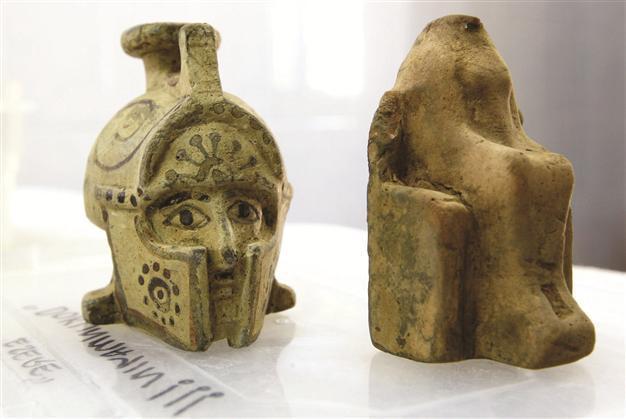Random discovery results with the first ‘Archeo Park’
IZMIR - Anatolia News Agency

There ara many artifacts unearthed during the excavation works. The area has been shown to be one of the 10 most important underwater sites. AA Photo
When ancient ruins were spotted in aerial photographs of the town of Urla in Izmir, steps were taken to initiate Turkey’s first underwater excavation. As a result a new archaeology park, Limantepe, was born.Limantepe is Turkey’s first underwater excavation site and work is being carried out there with the support of Ankara University’s Underwater Research Center. The area has been shown to be one of the 10 most important underwater excavations sites in the world, according to the head of the excavation, Prof. Hayat Erkanal. Limantepe is the site of an ancient city dating back to the Roman Empire, and also a site where hunter-gatherer societies later evolved into agricultural ones. The excavation began on land, with the underwater portion of the work beginning coincidentally, Erkanal said.
The first underwater archeaology park
“If someone had told me that this would be one of the important underwater archeological sites I would have laughed. Everything developed coincidentally,” Erkanal said. “We were given several aerial photos that the municipality had
taken in preparation for landscaping work in 1999. We saw some spots connected to the coast, and there we found the remnants of a harbor.
In the first years, we tried to conduct the excavations without professional support, but it didn’t work out. In those days, the University of Haifa in Israel and Ankara University signed an agreement. We asked for help [from them] as they had experience with underwater excavation. We worked together and learned many things.
There had been some work done previously on the wrecks of ancient ships, but no underwater excavations.
When Ankara University provided the necessary equipment, we established our underwater excavation team for the first time. The team quickly began finding important information. A two-winged harbor with a height of 350 to 400 meters, dating back to the 6th century B.C., was unearthed, which was the largest harbor of the time. Now, we are working at a depth of 7 to 8 meters on the floor of the harbor, where we have found the remains of a city spreading over one square kilometer.”
The process of desalinating the artifacts from the site will take six months, and it will be a year before they are ready to be exhibited, Erkanal said.
“We are finding many artifacts in the underwater excavation at Limantepe. When the laboratory is ready, we will be able to excavate a lot of historical artifacts. But we have to desalinate them first, to keep the artifacts in good condition. We can dig out the materials over several months, and then the other institutions will continue working on the pieces for a longer period. Several museums could be filled with these artifacts,” Erkanal said.
The team working at the site consists of 70 people, including students who are being trained to work on excavations throughout Turkey. Excavations will also be conducted at Teos and Eritrai.
Artifacts from ships are already being exhibited to shed light on the history of the site and attract citizens’ attention, Erkanal said. Many people visit the center to see how underwater excavations are carried out.
Tourists interested in excavation works
“Tourists are interested in the excavation work, so we established a program whereby tourism companies bring groups of tourists on determined days, and groups can visit by appointment. This led us to [creating] the Archeo Park project.
First we decided to establish a museum, but there is already work underway to establish a Museum of Aegean Civilizations in Izmir.
We thought that a museum in the town wouldn’t draw the intended number of tourists. We plan to exhibit ships and artifacts from them, to help describe the lifestyles of the past. We will use historical ships to take visitors on short trips, and people will be able to view an ancient ship dating back 3,000 years. Urla Municipality allocated 1.1 hectares of land to the project. This year, we are going to establish an Archeo Park with the support of the Koç Foundation, and next year, we are going to open the park, making Urla a significant world archaeological center. In the future, we plan to transform the park into the Naval Archeology Institution,” said Erkanal.
















